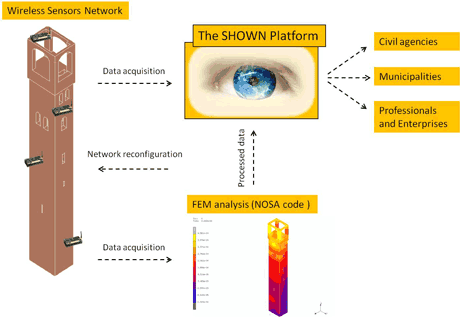by Paolo Barsocchi and Maria Girardi
Regular surveys of the structure of World Heritage buildings are essential to ensure their conservation. The aging of building materials, long-term ground subsidence, and environmental vibrations are all possible causes of the deterioration of old constructions. The potentially disastrous effects of severe seismic events are an additional factor teaching us the importance of prevention. When the constraints of architectural conservation are very strict, prevention mainly means monitoring.
While great efforts have been made to monitor the surfaces of ancient monuments, the level of the technology applied to control their “structural health” is still generally quite low. A typical programme of structural monitoring simply involves technicians using classical optical instruments periodically carrying out a series of measurements. More recently, procedures have been developed to test the structural health of ancient buildings by analysing their dynamic response to natural or artificial vibrations. Such procedures are recognized as a good way to test the state of conservation of a building, and are also important aids in identifying when interventions are necessary. They consist in taking regular measurements via wired acceleration and displacement sensors, which are removed after usage. Lately, microwave interferometry technology has been used to measure the vibration of buildings at great distances. Unfortunately, these techniques generally involve high maintenance costs and thus make the continuous acquisition of the large amounts of data necessary for effective monitoring impossible. In addition, wired sensors are too invasive and aesthetically unacceptable for widespread application to the architectural heritage.
In this context, Wireless Sensor Network (WSN) technology can make an important contribution by providing an economical and relatively non-invasive instrument for real-time structural monitoring of the well-being of buildings and monuments. We envisage their employment in a not too distant future in the monitoring of entire historic areas on a large-scale, facilitating the management of maintenance operations and prompt interventions in the case of an emergency. The installation of a WSN during the construction or the restoration of a building and its connection to a central database could become an ordinary or even compulsory operation. For these reasons, the structural monitoring of ancient buildings using wireless sensor network technology seems very promising. It could provide continuous observation and real-time feedback, allowing engineers to reconfigure the network, as necessary. WSN-based technology also offers the added benefits of low visual impact and low maintenance costs.
Up to now, in the field of cultural and architectural heritage, WSNs have been mainly used to monitor large archaeological areas or some interior parameters of ancient buildings and museums, such as moisture, temperature and fire. Applications of WSN technology to the structural monitoring of ancient buildings so far have been limited to few example applications and research projects. At the moment, several issues remain to be investigated, such as the number and location of the sensors used to acquire data and the maximisation of WSN lifetime. While energy consumption is a well-known problem in WSN applications, the optimisation of the number and location of sensors is a new challenge in these technologies, which typically involve a large number of redundant sensors.

Figure 1: The SHOWN Platform
The SHOWN platform, depicted in Figure 1, will move in this direction. The research is conducted by the Mechanics of Materials and Structures Laboratory and the Wireless Sensor Networks Laboratory of ISTI–CNR and a recent breakthrough is the development of wireless networks able to communicate through a minimum number of sensors, taking into account both structural and architectonic constraints on the one hand and radio signal propagation constraints on the other. Considerable attention is also being given to energy optimisation of the network, with particular regard to the high–frequency sampling sensors, such as accelerometers. All structural parameters are set and verified using the NOSA-ITACA code, a finite element software developed at ISTI-CNR to simulate the static and dynamic behaviour of ancient masonry.
Links:
[1] The Mechanics of Materials and Structures Laboratory: http://www.isti.cnr.it/research/unit.php?unit=MMS
[2] The Wireless Networks Laboratory (WN Lab) : http://www.isti.cnr.it/research/unit.php?unit=WN
[3] http://www.nosaitaca.it
Please contact:
Paolo Barsocchi and Maria Girardi, ISTI-CNR, Italy
E-mail:










